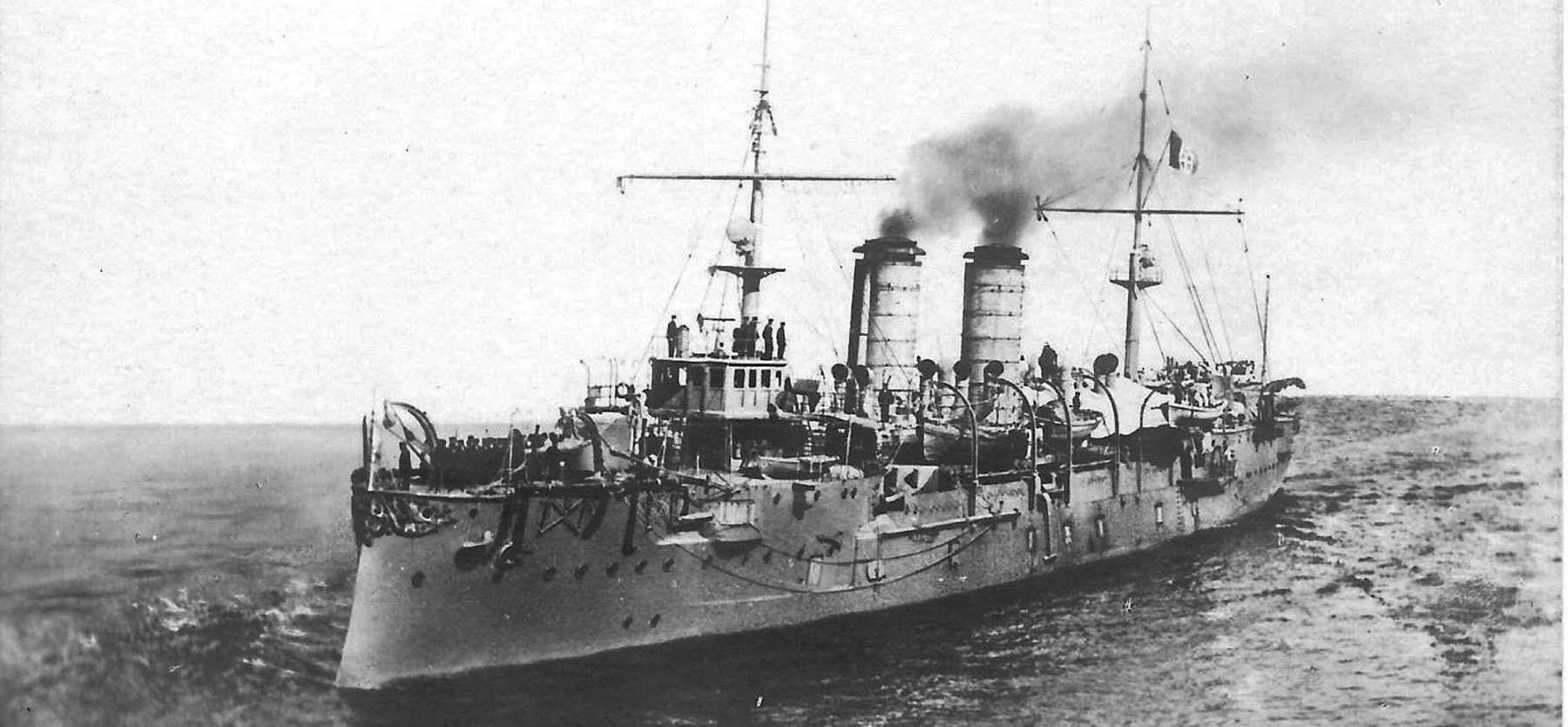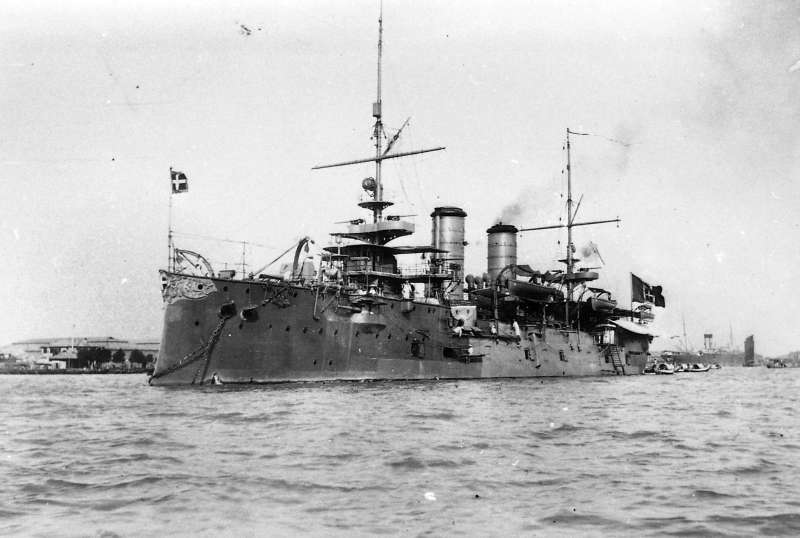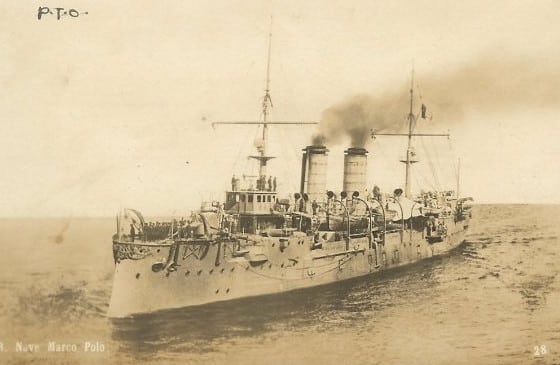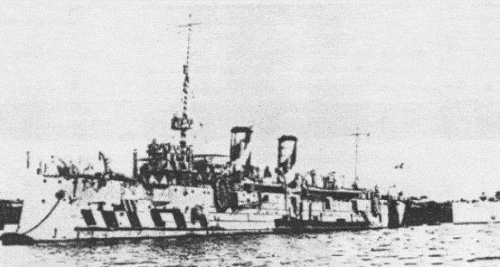The First Italian Armoured Cruiser
The Marco Polo was the first Italian armoured cruiser. She was designed by chief engineer Carlo Vigna in 1889, and laid down in January 1890 in Castellamare di Stabia but was closely based on the Etna class cruisers. She was modified during construction as an armored cruiser she was larger and theoretically faster, but without the heavy 254 mm artillery pieces of the Etna. Instead, her 152 mm pieces were complemented by a large 120 mm battery. But this choice led to several criticisms, and the Marco Polo was generally considered too lightly armed. In addition, her expected speed of 19 knots was never reached and remained as slow as the Etna.

HD rendition of the ship (Postcard), wikimedia cc
⚠ Note: This post is in writing. Completion expected in late 2023.
❯❯❯❯❯❯❯❯❯❯❯
Design
The ships was longer than the Etna at 106.05 meters (347 ft 11 in) overall versus 283 ft 6 in (86.4 m), wider at 14.67 m (48 ft 2 in) vs 13 m (42 ft 6 in), and the draft was deeper for about 8cm. Overall displacement was 4,583 t (4,511 long tons), much heavier than the Etna class at 3,474 long tons (3,530 t). Propulsion used two vertical triple-expansion steam engines fed by four Scotch marine boilers which produced 10,000 indicated horsepower (7,500 kW) versus 7,480 ihp (5,580 kW). Consequently top speed was rated (in theory) as much as 19 knots versus 17 which was a real progress, but in reality 17.2 knots was the most common figure, as she did 17.8 knots (33.0 km/h; 20.5 mph) at best by overheating its boilers and producing 10,663 ihp (7,951 kW). Radius was 5,800 nautical miles (10,700 km; 6,700 mi) versus 5,000 nautical miles (9,300 km; 5,800 mi) at 10 knots.
The armament seen the deletion of the heavy 254 mm pieces in favor of a concentrated battery of six 152 mm/40 (6.0 in) guns in single mounts which the Etna had already, for a secondary battery of ten rapid-firing single 120 mm (4.7 in) guns. The light battery was about the same, eleven 57 and 37 mm versus ten Hotchkiss revolver guns on the Etna. Its 100 mm (3.9 in) armored belt only stretched to the middle of the ship, starting and ending under the fore and aft ammunition wells. Gun shields and conning tower were protected by 51 mm of armour. Only the deck was protected on the Etna at 1.5-inch (38 mm).

Brassey’s Naval annual depicting the general scheme of the Italian cruiser

Postcard depicting the Marco Polo

Marco Polo used as the ship transport Cortelazzo in 1918 – cdts navypedia.org, from Conway’s Fighting ships 1906-1921
Illustration of the Marco Polo in 1914
Sardegna (1914) specifications |
|
| Dimensions | 106,50 (347 ft 11 in) x 14,57 (48 ft 2 in) x 5,88 m (19 ft 3 in) |
| Displacement | 4500 – 4820 t. FL |
| Crew | 394 |
| Propulsion | 2 screws, 2 VTE engines, 4 cyl. boilers, 10 660 hp |
| Speed | 17 knots (31 km/h; 20 mph) |
| Range | 5,800 nmi (10,700 km; 6,700 mi) at 10 knots (19 km/h; 12 mph) |
| Armament | 6 x 152, 4 x 120, 6 x 57, 2 x 37 mm, 2 howitzer, 2 ML, 4 TT 450 mm |
| Armor | Belt 150 mm, Decks 25 mm, CT 51 mm, shields 51 mm |
Links/Sources
On fr.naval-encyclopedia.com
Marco Polo on wikipedia
on navypedia.org
Conways all the world’s Fighting ships 1906-1921
Conways all the world’s fighting ships 1860-1906



 Latest Facebook Entry -
Latest Facebook Entry -  X(Tweeter) Naval Encyclopedia's deck archive
X(Tweeter) Naval Encyclopedia's deck archive Instagram (@navalencyc)
Instagram (@navalencyc)





 French Navy
French Navy Royal Navy
Royal Navy Russian Navy
Russian Navy Armada Espanola
Armada Espanola Austrian Navy
Austrian Navy K.u.K. Kriegsmarine
K.u.K. Kriegsmarine Dansk Marine
Dansk Marine Nautiko Hellenon
Nautiko Hellenon Koninklije Marine 1870
Koninklije Marine 1870 Marinha do Brasil
Marinha do Brasil Osmanlı Donanması
Osmanlı Donanması Marina Do Peru
Marina Do Peru Marinha do Portugal
Marinha do Portugal Regia Marina 1870
Regia Marina 1870 Nihhon Kaigun 1870
Nihhon Kaigun 1870 Preußische Marine 1870
Preußische Marine 1870 Russkiy Flot 1870
Russkiy Flot 1870 Svenska marinen
Svenska marinen Søværnet
Søværnet Union Navy
Union Navy Confederate Navy
Confederate Navy Armada de Argentina
Armada de Argentina Imperial Chinese Navy
Imperial Chinese Navy Marinha do Portugal
Marinha do Portugal Mexico
Mexico Kaiserliche Marine
Kaiserliche Marine 1898 US Navy
1898 US Navy Sovietskiy Flot
Sovietskiy Flot Royal Canadian Navy
Royal Canadian Navy Royal Australian Navy
Royal Australian Navy RNZN Fleet
RNZN Fleet Chinese Navy 1937
Chinese Navy 1937 Kriegsmarine
Kriegsmarine Chilean Navy
Chilean Navy Danish Navy
Danish Navy Finnish Navy
Finnish Navy Hellenic Navy
Hellenic Navy Polish Navy
Polish Navy Romanian Navy
Romanian Navy Turkish Navy
Turkish Navy Royal Yugoslav Navy
Royal Yugoslav Navy Royal Thai Navy
Royal Thai Navy Minor Navies
Minor Navies Albania
Albania Austria
Austria Belgium
Belgium Columbia
Columbia Costa Rica
Costa Rica Cuba
Cuba Czechoslovakia
Czechoslovakia Dominican Republic
Dominican Republic Haiti
Haiti Hungary
Hungary Honduras
Honduras Estonia
Estonia Iceland
Iceland Eire
Eire Equador
Equador Iran
Iran Iraq
Iraq Latvia
Latvia Liberia
Liberia Lithuania
Lithuania Mandchukuo
Mandchukuo Morocco
Morocco Nicaragua
Nicaragua Persia
Persia San Salvador
San Salvador Sarawak
Sarawak Uruguay
Uruguay Venezuela
Venezuela Zanzibar
Zanzibar Warsaw Pact Navies
Warsaw Pact Navies Bulgaria
Bulgaria Hungary
Hungary

 Bundesmarine
Bundesmarine Dutch Navy
Dutch Navy Hellenic Navy
Hellenic Navy Marina Militare
Marina Militare Yugoslav Navy
Yugoslav Navy Chinese Navy
Chinese Navy Indian Navy
Indian Navy Indonesian Navy
Indonesian Navy JMSDF
JMSDF North Korean Navy
North Korean Navy Pakistani Navy
Pakistani Navy Philippines Navy
Philippines Navy ROKN
ROKN Rep. of Singapore Navy
Rep. of Singapore Navy Taiwanese Navy
Taiwanese Navy IDF Navy
IDF Navy Saudi Navy
Saudi Navy Royal New Zealand Navy
Royal New Zealand Navy Egyptian Navy
Egyptian Navy South African Navy
South African Navy






























 Ukrainian Navy
Ukrainian Navy dbodesign
dbodesign